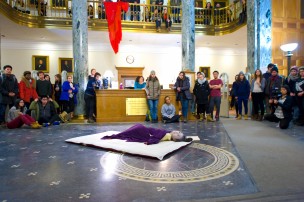Eiko Otake danced throughout the whole of Olin Memorial Library on Monday, Feb. 23. Her performance explored the human experience following the nuclear tragedy in Fukushima in 2011.
If you were finishing a paper or studying for a midterm in Olin on Monday night, you may have been distracted by a large group of students following a petite, white-painted woman in a white dress. The woman was Eiko Otake, a Japanese dancer and choreographer who is currently a Visiting Artist in Dance and College of East Asian Studies.
Otake began at 10 p.m. in the Olin lobby, moving throughout the building. She performed on the stairs, in doorways of various reading rooms, in the stacks, and, finally, finished near the large windows that face the center of campus. I have never worked so hard to simply be a member of the audience: onlookers climbed stairs, moved books aside to see through bookshelves, crouched, craned their necks, and stood on their tiptoes to view Otake as she roamed through the building.
Before this project, Otake worked with Takashi Koma Otake for over 40 years on collaborative pieces that extended beyond dancing. The two have choreographed for other dances, created “media dances” intended only to be filmed, and produced video documentaries.
This piece, which was Otake’s first solo project, is connected to the “A Body in Fukushima” exhibition currently displayed in the Zilkha Gallery that explores the 2011 tsunami in Japan, which caused the meltdown of a nuclear power plant in Fukushima. The exhibit consists of photos of Otake in various pained positions in front of the ruins of Fukushima and is meant to express the trauma of what occurred in this now-desolate city. Photographs from this exhibit were projected above the Olin stairs, and at one point Otake danced in front of the images.
Otake’s project began on Oct. 3, when she performed a three-hour piece called “A Body in a Station” at the Philadelphia Amtrak train station. The photographs, taken by Japanese historian William Johnston, were on view in the Pennsylvania Academy of Fine Arts. The dance portion focuses on exploring unconventional venues and interacting with the features of each setting in which Otake appears.
While she did take full advantage of various arbitrary features of Olin, from bookshelves to doors and staircases, Otake’s relationship with her audience was one devoid of communication: she moved through the crowd and it parted for her just in time to complete her movement, and she danced in locations only viewable by a few audience members at a time. The performance was completely about her own body, as if she had not necessarily intended the piece to be seen by anyone, let alone a large crowd of students.
On Otake and her partner’s website, they stress that “there is no clear rule for who [they] want [their] audience to be.” They also mention that they focus less on the audience’s interpretation of their work than the fact that watchers simply feel connected to it. This concept rang true for Otake’s solo project as well; while, as an audience member, I did not quite know how to interpret her work, I could feel the pain and trauma she was expressing in her movement.
This performance in particular also focuses on space (hence its name). As a soloist, Otake sees her partner as the environment around her, which includes the space she occupies as well as her audience. As students gathered around the edges of the lobby and peered down from the balcony above, the sounds of Olin persisted: a door squeaked as students entered, a phone rang and confused newcomers whispered.
Otake’s movement throughout the piece was relatively slow. From her starting position on a thin mattress in Olin’s lobby, she contorted herself into strained, painful-looking positions, moving almost imperceptibly to create these forms. On the website that she and her partner created, they clarify that they do not see their movement as slow.
“When we move, we take enough time to do something we like to taste and share.”
Another relevant aspect of the performance was the use of props, which consisted of the thin mattress on which Otake began her show (and which she later picked up and moved with her, subverting its original role in the piece), an open book next to the mattress, a blanket-like purple fabric that sheltered her during this first portion, and a small red cloth that she held behind her back, also during her time in the lobby. She eventually shed a few of these props, leaving a trail of them in the areas in which she danced.
The way that Otake’s piece explored the space that it was performed in may speak to the invasive aspect of the tsunami: Otake’s presence was far-reaching, plunging into the deepest depths of Olin and occupying spaces many students did not expect, just as natural disasters can appear unwelcome and victimize a widespread population.
“She seemed to be searching for something,” said Mimi Goss ’18, who was in the audience. “I could really feel her desperation, and the fact that she brought us with her on what felt like a quest made me feel a part of the performance itself.”

1 Comment
Pat Tully
This sounds like a wonderful performance–I’m sorry I missed it! Although Olin is first and foremost a study and research space, its beauty and variety make it a perfect venue for occasional performances such as this. Bravo!